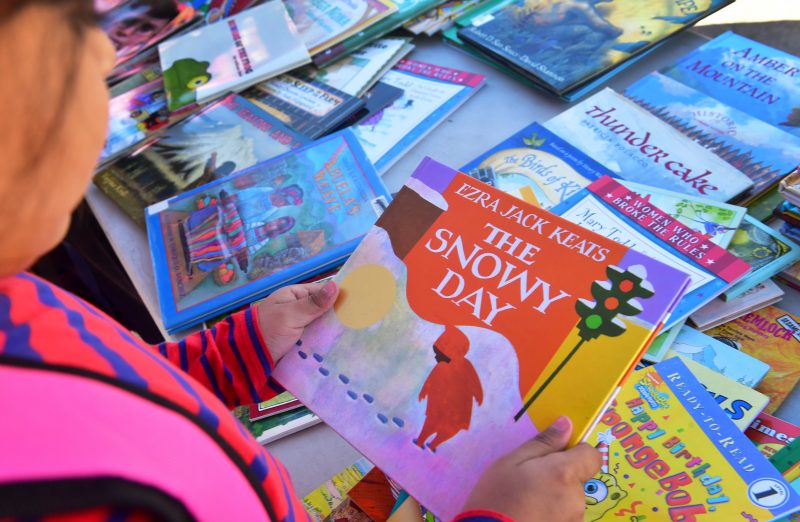Children not spared by California’s homelessness crisis
A student at Telfair Elementary School in Los Angeles county makes her choice for a free book during a morning at Operation School Bell — a quarter of the school’s 720 children are in need of food, shelter or clothing (Frederic J. BROWN)
Los Angeles (AFP) – Jose Razo, the principal of Telfair Elementary School in Los Angeles county, wants his students to spend their time worrying about homework, their grades or playdates.
But the harsh reality for more than a quarter of the 720 children at the school is far different — they are classified as homeless.
“Food, somewhere to sleep, something to put on their back: those are the challenges our students are facing,” says Razo.
“Someone seven or eight years old should not have to worry about that.”
According to the Los Angeles Unified School District, nearly 18,000 students in the district are classified as homeless and Telfair is at the epicenter of the crisis.
Built in 1945, the school is located in Pacoima, about a 30-minute drive north of downtown LA, and nearly all of its pupils — 98 percent — are Latino.
About half of the homeless students come from low-income families struggling to survive. They are forced to live with relatives, in shared homes, in garages — sometimes with no running water — or in mobile homes.
– ‘Tired and anxious’ –
Nearly every student is poor enough to qualify for free or reduced-price meals.
“When you have a single mom working to pay for two students and herself, and she’s just making the minimum wage ($12 an hour in LA), that’s barely enough for just the food,” says Razo, who himself experienced homelessness growing up.
“So families will double up, triple up, quadruple up in a house, and each family might rent a room for two or three children,” he added.
Razo said “home” for some of the pupils at Telfair is a living room where they are unlikely to get a good night’s sleep amid the comings and goings of the house’s other occupants.
“So they come here the next morning tired and anxious,” he said.
A small number of the students, Razo said, live in motels. The worst off live in RVs, shelters or even a car.
Teachers at the school said for some of these kids, a bathroom ends up being the only quiet place to do homework
The numbers are sobering in a state that is home to the world’s fifth-largest economy but has the nation’s highest poverty rate when cost-of-living is factored in.
“We need to break the cycle of poverty,” said Razo, a devout Catholic who served in the US Marine Corps and still sports a buzz cut.
“I tell the children my story. I tell them you may be poor now but you’re not going to be poor forever. Being poor is not right.”
– ‘Education is key’ –
“We’re trying to show the children that everything is possible, that they can achieve any kind of goal they want,” Razo adds, speaking in a soft voice.
And the 44-year-old tells the students day in and day out that the way to break out of poverty is through education.
“I keep telling them: ‘You can lose your house, you can lose your job, but there are two things people can’t take away from you — your will and your degree,'” he said.
“I know what I’m talking about. I grew up about a block from here too.”
With the odds stacked against the students, Razo said teachers at Telfair go the extra mile for their pupils and often dip into their own pockets to help out with school supplies or other items.
“The teacher’s job here is not just teaching,” he said. “They are social workers, counselors, therapists, nurses. They’re parents.”
Only last month, Razo and a teacher personally drove 10 of the poorest students to a community distribution center for supplies, including clothes, books and backpacks.
Kaila, one of the children on the trip, was interested in books.
“Reading is the most important,” she shyly tells an AFP reporter who accompanied the group.
Angel, for his part, had his sights on a pair of black tennis shoes.
“Shoes make me more happy,” exclaimed the seven-year-old as he proudly showed off the new sneakers on his feet.
Razo said he has helped out many of the students at his school who are living in poverty and without a home.
“One day, it was raining heavily,” he said. “Several of the children did not come to school because they had holes in their shoes.”
Disclaimer: This story is published from a syndicated feed. Siliconeer does not assume any liability for the above story. Validity of the above story is for 7 Days from original date of publishing. Content copyright AFP.


